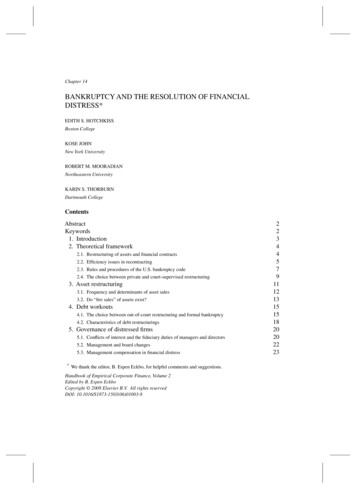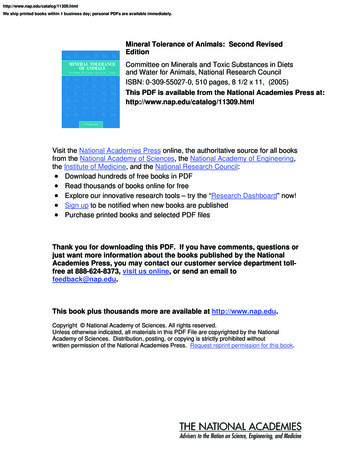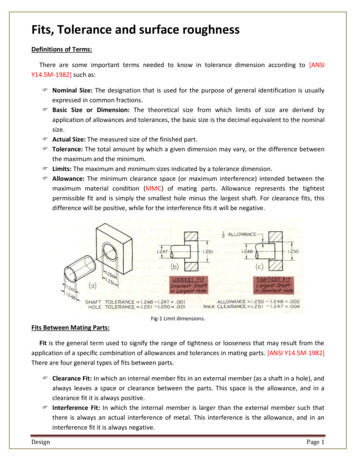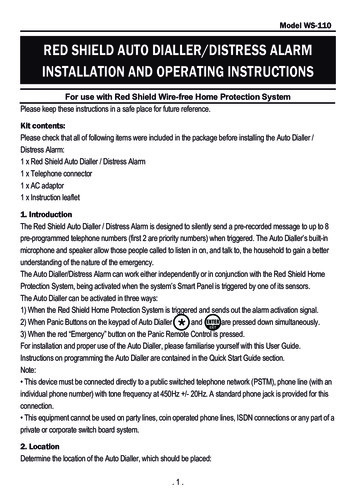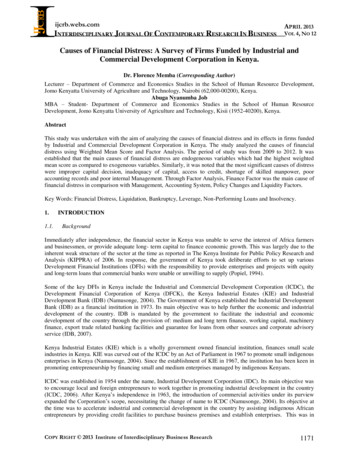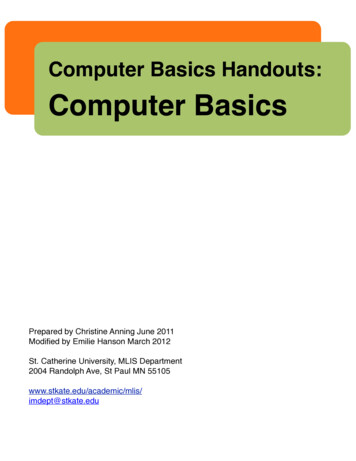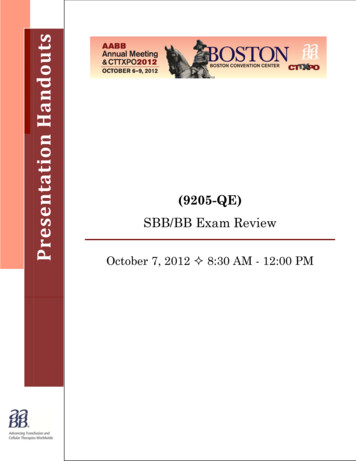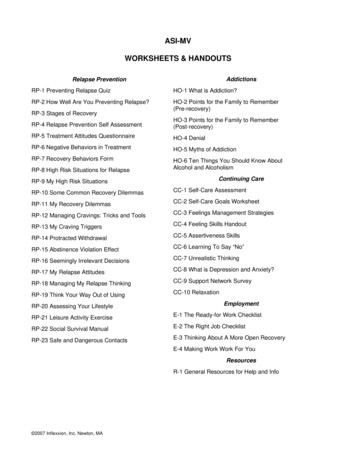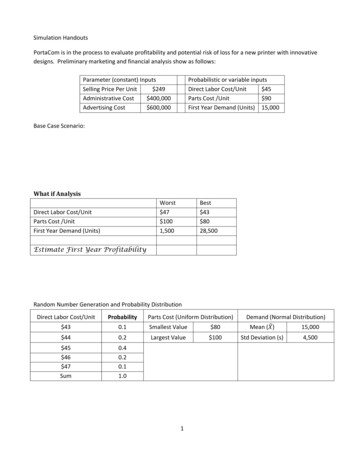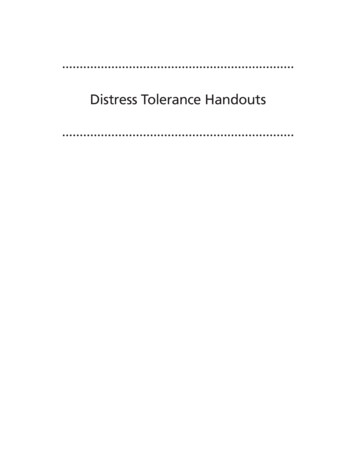
Transcription
Distress Tolerance Handouts
DISTRESS TOLERANCE HANDOUT 1Goals of Distress ToleranceSURVIVE CRISIS SITUATIONSWithout Making Them WorseACCEPT REALITYReplace Suffering and Being “Stuck”with Ordinary Pain and the Possibility of Moving ForwardBECOME FREEOf Having to Satisfythe Demands of Your OwnDesires, Urges, and Intense EmotionsOTHER:From DBT Skills Training Handouts and Worksheets, Second Edition, by Marsha M. Linehan. Copyright 2015 by Marsha M. Linehan. Permission to photocopy this handout is granted to purchasers of DBT Skills Training Handouts and Worksheets, Second Edition, and DBT SkillsTraining Manual, Second Edition, for personal use and use with individual clients only. (See page ii of this packet for details.)
DISTRESS TOLERANCE HANDOUT 3When to Use Crisis Survival SkillsYOU ARE IN A CRISIS when the situation is: Highly stressful. Short-term (that is, it won’t last a long time). Creates intense pressure to resolve the crisis now.USE CRISIS SURVIVAL SKILLS when:1.2.3.4.5.You have intense pain that cannot be helped quickly.You want to act on your emotions, but it will only make things worse.Emotion mind threatens to overwhelm you, and you need to stay skillful.You are overwhelmed, yet demands must be met.Arousal is extreme, but problems can’t be solved immediately.DON’T USE CRISIS SURVIVAL SKILLS for: Everyday problems. Solving all your life problems. Making your life worth living.From DBT Skills Training Handouts and Worksheets, Second Edition, by Marsha M. Linehan. Copyright 2015 by Marsha M. Linehan. Permission to photocopy this handout is granted to purchasers of DBT Skills Training Handouts and Worksheets, Second Edition, and DBT SkillsTraining Manual, Second Edition, for personal use and use with individual clients only. (See page ii of this packet for details.)
DISTRESS TOLERANCE HANDOUT 4(Distress Tolerance Worksheets 2, 2a)373–273. pp;STOP SkillSTOPtopDo not just react. Stop! Freeze! Do not move amuscle! Your emotions may try to make you actwithout thinking. Stay in control!ake a step backTake a step back from the situation. Take a break. Letgo. Take a deep breath. Do not let your feelings makeyou act impulsively.bserveNotice what is going on inside and outside you. Whatis the situation? What are your thoughts and feelings?What are others saying or doing?roceed mindfullyAct with awareness. In deciding what to do, consideryour thoughts and feelings, the situation, and otherpeople’s thoughts and feelings. Think about yourgoals. Ask Wise Mind: Which actions will make itbetter or worse?Note. Adapted from an unpublished worksheet by Francheska Perepletchikova and Seth Axelrod, with their permission.From DBT Skills Training Handouts and Worksheets, Second Edition, by Marsha M. Linehan. Copyright 2015 by Marsha M. Linehan. Permission to photocopy this handout is granted to purchasers of DBT Skills Training Handouts and Worksheets, Second Edition, and DBT SkillsTraining Manual, Second Edition, for personal use and use with individual clients only. (See page ii of this packet for details.)
DISTRESS TOLERANCE HANDOUT 5(Distress Tolerance Worksheets 3, 3a )573–473. pp;Pros and ConsUse pros and cons any time you have to decide between two courses of action.An urge is a crisis when it is very strong and when acting on the urge will make things worse inthe long term.Make a list of the pros and cons of acting on your crisis urges. These might be to engage indangerous, addictive, or harmful behaviors, or they might be to give in, give up, or avoid doingwhat is necessary to build a life you want to live.Make another list of the pros and cons of resisting crisis urges—that is, tolerating the distressand not giving in to the urges.Use the grid below to evaluate both sets of pros and cons (this type of grid is also used inDistress Tolerance Worksheet 3). Or you can use the type of grid seen in Distress ToleranceWorksheet 3a and in the pros-and-cons worksheets for other modules.PROSActingon crisisurgesResistingcrisisurgesCONSPros of acting on impulsive urges,giving in, giving up, or avoiding whatneeds to be done.Cons of acting on impulsive urges,giving in, giving up, or avoiding whatneeds to be done.Pros of resisting impulsive urges,doing what needs to be done, andnot giving up.Cons of resisting impulsive urges,doing what needs to be done, andnot giving up.Before an overwhelming crisis urge hits:Write out your pros and cons; carry them with you.Rehearse your pros and cons over and over.When an overwhelming crisis urge hits:Review your pros and cons. Get out your list and read it over again. Imagine the positive consequences of resisting the urge. Think of the negative consequences of giving in to crisis behaviors. Remember past consequences when you have acted on crisis urges.From DBT Skills Training Handouts and Worksheets, Second Edition, by Marsha M. Linehan. Copyright 2015 by Marsha M. Linehan. Permission to photocopy this handout is granted to purchasers of DBT Skills Training Handouts and Worksheets, Second Edition, and DBT SkillsTraining Manual, Second Edition, for personal use and use with individual clients only. (See page ii of this packet for details.)
DISTRESS TOLERANCE HANDOUT 6(Distress Tolerance Worksheet 4)673.p;TIP Skills: Changing Your Body ChemistryTo reduce extreme emotion mind fast.Remember these as TIP skills:TITIP THE TEMPERATURE of your face with COLD WATER*(to calm down fast) Holding your breath, put your face in a bowl of cold water,or hold a cold pack (or zip-lock bag of cold water) on your eyes and cheeks. Hold for 30 seconds. Keep water above 50 F.INTENSE EXERCISE*(to calm down your body when it is revved up by emotion) Engage in intense exercise, if only for a short while. Expend your body’s stored up physical energy by running, walking fast, jumping,playing basketball, lifting weights, etc.PACED BREATHING(pace your breathing by slowing it down)P Breathe deeply into your belly. Slow your pace of inhaling and exhaling way down (on average, five to six breathsper minute). Breathe out more slowly than you breathe in (for example, 5 seconds in and 7seconds out).PAIRED MUSCLE RELAXATION(to calm down by pairing muscle relaxation with breathing out) While breathing into your belly deeply tense your body muscles (not so much asto cause a cramp). Notice the tension in your body. While breathing out, say the word “Relax” in your mind. Let go of the tension. Notice the difference in your body.*Caution: Very cold water decreases your heart rate rapidly. Intense exercise will increase heart rate. Consult your health care provider beforeusing these skills if you have a heart or medical condition, a lowered base heart rate due to medications, take a beta-blocker, are allergic tocold, or have an eating disorder.From DBT Skills Training Handouts and Worksheets, Second Edition, by Marsha M. Linehan. Copyright 2015 by Marsha M. Linehan. Permission to photocopy this handout is granted to purchasers of DBT Skills Training Handouts and Worksheets, Second Edition, and DBT SkillsTraining Manual, Second Edition, for personal use and use with individual clients only. (See page ii of this packet for details.)
DISTRESS TOLERANCE HANDOUT 6A(Distress Tolerance Worksheet 4 )673.p;Using Cold Water, Step by StepCOLD WATER CAN WORK WONDERS*When you put your full face into cold water . . . or you put a zip-lock bagwith cold water on your eyes and upper cheeks, and hold your breath, ittells your brain you are diving underwater.This causes the “dive response” to occur. (It may take 15–30 seconds tostart.)Your heart slows down, blood flow to nonessential organs is reduced, andblood flow is redirected to the brain and heart.This response can actually help regulate your emotions.This will be useful as a distress tolerance strategy when you are havinga very strong, distressing emotion, or when you are having very strongurges to engage in dangerous behaviors.(This strategy works best when you are sitting quietly—activity anddistraction may make it less effective.)TRY IT OUT!*Caution: Very cold water decreases your heart rate. If you have any heart or medical condition, have a lowered base heart rate due to medications, or are on a beta-blocker, consult your health care provider before using these skills. Avoid ice water if you are allergic to the cold.From DBT Skills Training Handouts and Worksheets, Second Edition, by Marsha M. Linehan. Copyright 2015 by Marsha M. Linehan. Permission to photocopy this handout is granted to purchasers of DBT Skills Training Handouts and Worksheets, Second Edition, and DBT SkillsTraining Manual, Second Edition, for personal use and use with individual clients only. (See page ii of this packet for details.)
DISTRESS TOLERANCE HANDOUT 7(Distress Tolerance Worksheets 5–5b )183–973. pp;DistractingA way to remember these skills is the phrase “Wise Mind ACCEPTS.”With Activities:Focus attention on a task you need to getGo out for a meal or eat a favorite food.done.Call or go out with a friend.Rent movies; watch TV.Listen to your iPod; download music.Clean a room in your house.Build something.Find an event to go to.Spend time with your children.Play computer games.Play cards.Go walking. Exercise.Read magazines, books, comics.Surf the Internet. Write e-mails.Do crossword puzzles or Sudoku.Play sports.Other:With Contributing:Find volunteer work to do.Call or send an instant message encouragingHelp a friend or family member.someone or just saying hi.Surprise someone with something nice (aMake something nice for someone else.card, a favor, a hug).Do something thoughtful.Give away things you don’t need.Other:With Comparisons:Compare how you are feeling now to a timeCompare yourself to those less fortunate.when you felt different.Watch reality shows about others’ troubles;Think about people coping the same as you orread about disasters, others’ suffering.less well than you.Other:With different Emotions:Read emotional books or stories, old letters.Ideas: Scary movies, joke books, comedies,Watch emotional TV shows; go to emotionalfunny records, religious music, soothing musicmovies.or music that fires you up, going to a store andListen to emotional music.reading funny greeting cards.(Be sure the event creates different emotions.)Other:With Pushing away:Push the situation away by leaving it for aNotice ruminating: Yell “No!”while.Refuse to think about the painful situations.Leave the situation mentally.Put the pain on a shelf. Box it up and put itBuild an imaginary wall between yourself andaway for a while.the situation.Deny the problem for the moment.Block thoughts and images from your mind.Other:With other Thoughts:Count to 10; count colors in a painting orWork puzzles.poster or out the window; count anything.Watch TV or read.Repeat words to a song in your mind.Other:Squeeze a rubber ball very hard.Listen to very loud music.Hold ice in your hand or mouth.With other Sensations:Go out in the rain or snow.Take a hot or cold shower.Other:From DBT Skills Training Handouts and Worksheets, Second Edition, by Marsha M. Linehan. Copyright 2015 by Marsha M. Linehan. Permission to photocopy this handout is granted to purchasers of DBT Skills Training Handouts and Worksheets, Second Edition, and DBT SkillsTraining Manual, Second Edition, for personal use and use with individual clients only. (See page ii of this packet for details.)
DISTRESS TOLERANCE HANDOUT 8(Distress Tolerance Worksheet 6–6b )483–283. pp;Self-SoothingA way to remember these skills is to think of soothing each of your FIVE SENSES.With Vision:Look at the stars at night.Sit in the lobby of a beautiful old hotel.Look at pictures you like in a book.Look at nature around you.Buy one beautiful flower.Walk in a pretty part of town.Make one space in a room pleasing to look at.Watch a sunrise or a sunset.Light a candle and watch the flame.Go to a dance performance, or watch it on TV.Set a pretty place at the table using your bestBe mindful of each sight that passes in front ofthings.you.Go people-watching or window-shopping.Take a walk in a park or a scenic hike.Go to a museum or poster shop with beautifulBrowse through stores looking at things.art.Other:With Hearing:Listen to soothing or invigorating music.Burn a CD or make an iPod mix with musicPay attention to sounds of nature (waves,that will get you through tough times. Turn itbirds, rainfall, leaves rustling).on.Pay attention to the sounds of the city (traffic,Be mindful of any sounds that come your way,horns, city music).letting them go in one ear and out the other.Sing to your favorite songs.Turn on the radio.Hum a soothing tune.Other:Learn to play an instrument.With Smell:Use your favorite soap, shampoo, aftershave,Sit in a new car and breathe the aroma.cologne, or lotions, or try them on in the store.Boil cinnamon. Make cookies, bread, orBurn incense or light a scented candle.popcorn.Open a package of coffee and inhale theSmell the roses.aroma.Walk in a wooded area and mindfully breathePut lemon oil on your furniture.in the fresh smells of nature.Put potpourri or eucalyptus oil in a bowl in yourOpen the window and smell the air.room.Other:With Taste:Eat some of your favorite foods.Suck on a piece of peppermint candy.Drink your favorite soothing drink, suchChew your favorite gum.as herbal tea, hot chocolate, a latté, or aGet a little bit of a special food you don’tsmoothie.usually spend the money on, such as freshTreat yourself to a dessert.squeezed orange juice or your favorite candy.Eat macaroni and cheese or another favoriteReally taste the food you eat. Eat one thingchildhood food.mindfully.Sample flavors in an ice cream store.Other:With Touch:Take a long hot bath or shower.Take a drive with the car windows rolled down.Pet your dog or cat.Run your hand along smooth wood or leather.Have a massage. Soak your feet.Hug someone.Put creamy lotion on your whole body.Put clean sheets on the bed.Put a cold compress on your forehead.Wrap up in a blanket.Sink into a comfortable chair in your home.Notice touch that is soothing.Put on a blouse or shirt that has a pleasantOther:feel.From DBT Skills Training Handouts and Worksheets, Second Edition, by Marsha M. Linehan. Copyright 2015 by Marsha M. Linehan. Permission to photocopy this handout is granted to purchasers of DBT Skills Training Handouts and Worksheets, Second Edition, and DBT SkillsTraining Manual, Second Edition, for personal use and use with individual clients only. (See page ii of this packet for details.)
DISTRESS TOLERANCE HANDOUT 9(Distress Tolerance Worksheets 7, 7a, 7b )883–683. pp;Improving the MomentA way to remember these skills is the word IMPROVE.With Imagery:Imagine very relaxing scenes.Imagine hurtful emotions draining out of youImagine a secret room within yourself. Furnishlike water out of a pipe.it the way you like. Close and lock the door onRemember a happy time and imagine yourselfanything that can hurt you.in it again; play out the time in your mindImagine everything going well.again.Make up a calming fantasy world.Other:With Meaning:Find purpose or meaning in a painful situation.Remember, listen to, or read about spiritualFocus on whatever positive aspects of avalues.painful situation you can find.Other:Repeat these positive aspects in your mind.With Prayer:Open your heart to a supreme being, God, orTurn things over to God or a higher being.your own Wise Mind.Other:Ask for strength to bear the pain.Take a hot bath or sit in a hot tub.Drink hot milk.Massage your neck and scalp.Practice yoga or other stretching.With Relaxing actions:Breathe deeply.Change your facial expression.Other:With One thing in the moment:Focus your entire attention on just what youFocus your entire attention on the physicalare doing.Listen to a sensory awareness recording (orKeep yourself in the moment.use Distress Tolerance Handout 9a)Put your mind in the present.Other:With a brief Vacation:Give yourself a brief vacation.Take a blanket to the park and sit on it for aGet in bed; pull the covers up over your head.whole afternoon.Go to the beach or the woods for the day.Take a 1-hour breather from hard work.Get a magazine and read it with chocolates.Take a brief vacation from responsibility.Turn off your phone for a day.Other:With self-Encouragement and rethinking the situation:Cheerlead yourself: “You go, girl!” “You da“This too shall pass.”man!”“I will be OK.”“I will make it out of this.”“It won’t last forever.”“I’m doing the best I can.”Other:Repeat over and over: “I can stand it.”List (and then practice) rethoughts that are particularly important in your crisis situations (e.g., “The fact that he didnot pick me up doesn’t mean he doesn’t love me”):From DBT Skills Training Handouts and Worksheets, Second Edition, by Marsha M. Linehan. Copyright 2015 by Marsha M. Linehan. Permission to photocopy this handout is granted to purchasers of DBT Skills Training Handouts and Worksheets, Second Edition, and DBT SkillsTraining Manual, Second Edition, for personal use and use with individual clients only. (See page ii of this packet for details.)
DISTRESS TOLERANCE HANDOUT 10(Distress Tolerance Worksheets 8–12a)004–193. pp;Overview:Reality Acceptance SkillsThese are skills for how to live a life that is not the life you want.RADICAL ACCEPTANCETURNING THE MINDWILLINGNESSHALF-SMILING AND WILLING HANDSALLOWING THE MIND:MINDFULNESS OF CURRENT THOUGHTSFrom DBT Skills Training Handouts and Worksheets, Second Edition, by Marsha M. Linehan. Copyright 2015 by Marsha M. Linehan. Permission to photocopy this handout is granted to purchasers of DBT Skills Training Handouts and Worksheets, Second Edition, and DBT SkillsTraining Manual, Second Edition, for personal use and use with individual clients only. (See page ii of this packet for details.)
DISTRESS TOLERANCE HANDOUT 11(Distress Tolerance Worksheets 8–9a)593–193. pp;Radical Acceptance(When you cannot keep painful events and emotions from coming your way.)WHAT IS RADICAL ACCEPTANCE?1. Radical means all the way, complete and total.2. It is accepting in your mind, your heart, and your body.3. It’s when you stop fighting reality, stop throwing tantrums because reality is notthe way you want it, and let go of bitterness.WHAT HAS TO BE ACCEPTED?1. Reality is as it is (the facts about the past and the present are the facts, even ifyou don’t like them).2. There are limitations on the future for everyone (but only realistic limitations needto be accepted).3. Everything has a cause (including events and situations that cause you pain andsuffering).4. Life can be worth living even with painful events in it.WHY ACCEPT REALITY?1. Rejecting reality does not change reality.2. Changing reality requires first accepting reality.3. Pain can’t be avoided; it is nature’s way of signaling that something is wrong.4. Rejecting reality turns pain into suffering.5. Refusing to accept reality can keep you stuck in unhappiness, bitterness, anger,sadness, shame, or other painful emotions.6. Acceptance may lead to sadness, but deep calmness usually follows.7. The path out of hell is through misery. By refusing to accept the misery that ispart of climbing out of hell, you fall back into hell.From DBT Skills Training Handouts and Worksheets, Second Edition, by Marsha M. Linehan. Copyright 2015 by Marsha M. Linehan. Permission to photocopy this handout is granted to purchasers of DBT Skills Training Handouts and Worksheets, Second Edition, and DBT SkillsTraining Manual, Second Edition, for personal use and use with individual clients only. (See page ii of this packet for details.)
DISTRESS TOLERANCE HANDOUT 11ARadical Acceptance: Factors That InterfereRADICAL ACCEPTANCE IS NOT:Approval, compassion, love, passivity, or against change.FACTORS THAT INTERFERE WITH ACCEPTANCE1. You don’t have the skills for acceptance; you do not knowhow to accept really painful events and facts.2. You believe that if you accept a painful event, you aremaking light of it or are approving of the facts, and thatnothing will be done to change or prevent future painfulevents.3. Emotions get in the way (unbearable sadness; anger atthe person or group that caused the painful event; rage atthe injustice of the world; overwhelming shame about whoyou are; guilt about your own behavior).Other:From DBT Skills Training Handouts and Worksheets, Second Edition, by Marsha M. Linehan. Copyright 2015 by Marsha M. Linehan. Permission to photocopy this handout is granted to purchasers of DBT Skills Training Handouts and Worksheets, Second Edition, and DBT SkillsTraining Manual, Second Edition, for personal use and use with individual clients only. (See page ii of this packet for details.)
DISTRESS TOLERANCE HANDOUT 11B(Distress Tolerance Worksheets 9, 9a)593–493. pp;Practicing Radical Acceptance Step by StepObserve that you are questioning or fighting reality (“It shouldn’t be this way”).Remind yourself that the unpleasant reality is just as it is and cannot be changed (“This is whathappened”).Remind yourself that there are causes for the reality. Acknowledge that some sort of history ledup to this very moment. Consider how people’s lives have been shaped by a series of factors.Notice that given these causal factors and how history led up to this moment, this reality had tooccur just this way (“This is how things happened”).Practice accepting with the whole self (mind, body, and spirit). Be creative in finding waysto involve your whole self. Use accepting self-talk—but also consider using relaxation;mindfulness of your breath; half-smiling and willing hands while thinking about what feelsunacceptable; prayer; going to a place that helps bring you to acceptance; or imagery.Practice opposite action. List all the behaviors you would do if you did accept the facts. Thenact as if you have already accepted the facts. Engage in the behaviors that you would do if youreally had accepted.Cope ahead with events that seem unacceptable. Imagine (in your mind’s eye) believing whatyou don’t want to accept. Rehearse in your mind what you would do if you accepted whatseems unacceptable.Attend to body sensations as you think about what you need to accept.Allow disappointment, sadness, or grief to arise within you.Acknowledge that life can be worth living even when there is pain.Do pros and cons if you find yourself resisting practicing acceptance.From DBT Skills Training Handouts and Worksheets, Second Edition, by Marsha M. Linehan. Copyright 2015 by Marsha M. Linehan. Permission to photocopy this handout is granted to purchasers of DBT Skills Training Handouts and Worksheets, Second Edition, and DBT SkillsTraining Manual, Second Edition, for personal use and use with individual clients only. (See page ii of this packet for details.)
DISTRESS TOLERANCE HANDOUT 12(Distress Tolerance Worksheets 8, 8a, 10)693, 293–193. pp;Turning the MindTURNING THE MIND is like facing a fork in the road. Youhave to turn your mind toward the acceptance road, andaway from the road of rejecting reality.TURNING THE MIND is choosing to accept.The CHOICE to accept does not itself equal acceptance.It just puts you on the path.TURNING THE MIND, STEP BY STEP1. OBSERVE that you are not accepting.(Look for anger, bitterness, annoyance;avoiding emotions; saying “Why me?”,“Why is this happening?”, “I can’t standthis,” “It shouldn’t be this way.”)RejectionAcceptanceIf you are here . . .2. Go within yourself and MAKE ANINNER COMMITMENT to accept realityas it is.3. DO IT AGAIN, over and over. Keepturning your mind to acceptance eachtime you come to the fork in the roadwhere you can reject reality or accept it.4. DEVELOP A PLAN for catching yourselfin the future when you drift out ofacceptance.From DBT Skills Training Handouts and Worksheets, Second Edition, by Marsha M. Linehan. Copyright 2015 by Marsha M. Linehan. Permission to photocopy this handout is granted to purchasers of DBT Skills Training Handouts and Worksheets, Second Edition, and DBT SkillsTraining Manual, Second Edition, for personal use and use with individual clients only. (See page ii of this packet for details.)
DISTRESS TOLERANCE HANDOUT 13(Distress Tolerance Worksheets 8, 8a, 10 )693, 293–193. pp;WillingnessWillingness is readiness to enter and participate fully in life and living.Find a WILLING RESPONSE to each situation.Willingness is DOING JUST WHAT IS NEEDED: In each situation. Wholeheartedly, without dragging your feet.Willingness is listening very carefully to your WISE MIND, and thenacting from your WISE MIND.Willingness is ACTING WITH AWARENESS that you are connectedto the universe (to the stars, people you like and don’t like, the floor,etc.).Replace WILLFULNESS with WILLINGNESS. Willfulness is REFUSING TO TOLERATE the moment.Willfulness is refusing to make changes that are needed.Willfulness is GIVING UP.Willfulness is the OPPOSITE OF “DOING WHAT WORKS.”Willfulness is trying to FIX EVERY SITUATION.Willfulness is insisting on BEING IN CONTROL.Willfulness is ATTACHMENT TO “ME, ME, ME” and “what I wantright now!”WILLINGNESS, STEP BY STEP1. OBSERVE the willfulness. Label it. Experience it.2. RADICALLY ACCEPT that at this moment you feel (and may beacting) willful. You cannot fight willfulness with willfulness.3. TURN YOUR MIND toward acceptance and willingness.4. Try HALF-SMILING and a WILLING POSTURE.5. When willfulness is immovable, ASK, “WHAT’S THE THREAT?”Situations where I notice my own:Willfulness:Willingness:From DBT Skills Training Handouts and Worksheets, Second Edition, by Marsha M. Linehan. Copyright 2015 by Marsha M. Linehan. Permission to photocopy this handout is granted to purchasers of DBT Skills Training Handouts and Worksheets, Second Edition, and DBT SkillsTraining Manual, Second Edition, for personal use and use with individual clients only. (See page ii of this packet for details.)
DISTRESS TOLERANCE HANDOUT 14(Distress Tolerance Worksheets 8, 8a, 11)793, 293–193. pp;Half-Smiling and Willing HandsAccepting reality with your body.HALF-SMILING1st. Relax your face from the top of your head down to your chin and jaw.Let go of each facial muscle (forehead, eyes, and brows; cheeks,mouth, and tongue; teeth slightly apart). If you have difficulty, trytensing your facial muscles and then letting go.A tense smile is a grin (and might tell your brain you are hiding ormasking your real feelings).2nd. Let both corners of your lips go slightly up, just so you can feel them.It is not necessary for others to see it. A half-smile is slightlyupturned lips with a relaxed face.3rd. Try to adopt a serene facial expression.Remember, your face communicates to your brain; your bodyconnects to your mind.WILLING HANDSStanding:Drop your arms down from your shoulders; keep themstraight or bent slightly at the elbows. With handsunclenched, turn your hands outward, with thumbs out toyour sides, palms up, and fingers relaxed.Sitting:Place your hands on your lap or your thighs. With handsunclenched, turn your hands outward, with palms up andfingers relaxed.Lying down:Arms by your side, hands unclenched, turn your palmsup with fingers relaxed.Remember, your hands communicate to your brain; your body connects toyour mind.From DBT Skills Training Handouts and Worksheets, Second Edition, by Marsha M. Linehan. Copyright 2015 by Marsha M. Linehan. Permission to photocopy this handout is granted to purchasers of DBT Skills Training Handouts and Worksheets, Second Edition, and DBT SkillsTraining Manual, Second Edition, for personal use and use with individual clients only. (See page ii of this packet for details.)
DISTRESS TOLERANCE HANDOUT 14A(p. 1 of 2)(Distress Tolerance Worksheet 10 )693.p;Practicing Half-Smiling and Willing Hands1. HALF-SMILE WHEN YOU FIRST WAKE UP IN THE MORNING.Hang a branch, any other sign, or even the word “smile” on the ceiling or wall, so that you see itright away when you open your eyes. This sign will serve as your reminder. Use these secondsbefore you get out of bed to take hold of your breath. Inhale and exhale three breaths gentlywhile maintaining a half-smile. Follow your breaths. Add willing hands to your half-smile, orpractice willing hands alone.2. HALF-SMILE DURING YOUR FREE MOMENTS.Anywhere you find yourself sitting or standing, half-smile. Look at a child, a leaf, a painting on awall, or anything that is relatively still, and smile. Inhale and exhale quietly three times.3. HALF-SMILE WITH WILLING HANDS WHILE YOU ARE LISTENING TO MUSIC.Listen to a piece of music for 2 or 3 minutes. Pay attention to the words, music, rhythm, andsentiments of the music you are listening to (not your daydreams of other times). Half-smilewhile watching your inhalations and exhalations. Adopt a willing-hands posture.4. HALF-SMILE WITH WILLING HANDS WHEN YOU ARE IRRITATED.When you realize “I’m irritated,” half-smile or adopt a willing-hands posture at once. Inhale andexhale quietly, maintaining a half-smile or willing hands for three breaths.5. HALF-SMILE IN A LYING-DOWN POSITION.Lie on your back on a flat surface, without the support of mattress or pillow. Keep your two armsloosely by your sides, and keep your two legs slightly apart, stretched out before you. Maintainwilling hands and a half-smile. Breathe in and out gently, keeping your attention focused onyour breath. Let go of every muscle in your body. Relax each muscle as though it were sinkingdown through the floor, or as though it were as soft and yielding as a piece of silk hanging inthe breeze to dry. Let go entirely, keeping your attention only on your breath and half-smile.Think of yourself as a cat, completely relaxed before a warm fire, whose muscles yield withoutresistance to anyone’s touch. Continue for 15 breaths.6. HALF-SMILE IN A SITTING POSITION.Sit on the floor with your back straight, or on a chair with your two feet touching the floor. Halfsmile. Inhale and exhale while maintaining the half-smile. Let go.(continued on next page)Note. Exercises 1 and 3–7 are adapted from The Miracle of Mindfulness (pp. 77–81, 93) by Thich Nh
with cold water on your eyes and upper cheeks, and hold your breath, it tells your brain you are diving underwater. This causes the “dive response” to occur. (It may take 15–30 seconds to start.) Your heart slows down, blood flow to nonessential organs is reduced, and
